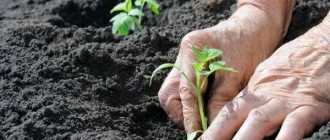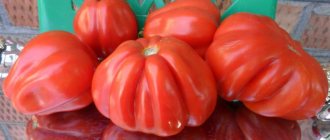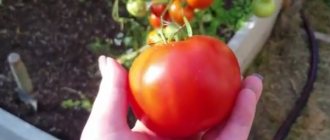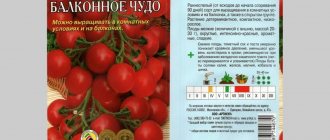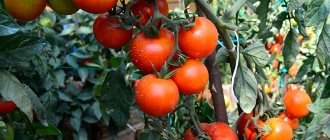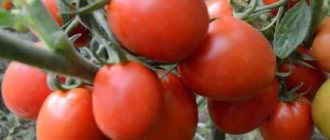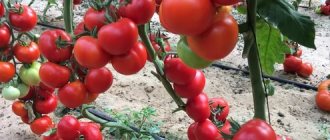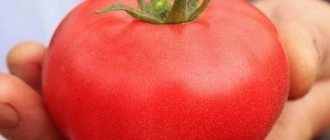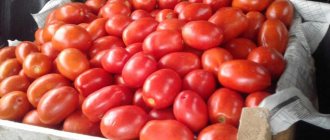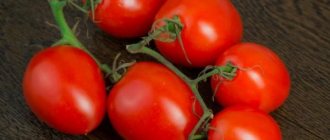| Ripening period: | mid-early (110 days from germination) |
| Shape, weight of fruits: | round, red, weight 100-140 g |
| Determinacy: | tall (200-250 cm) |
| Growing regions: | in greenhouses throughout Russia, open ground in the south |
| Productivity: | up to 12 kg per plant |
Choosing a suitable tomato variety for growing on your personal farm is not an easy task. Gardeners are presented with hundreds of varieties: low-growing and tall, cherry, beef tomatoes, red, yellow, black, productive and not very productive. Tomato Tolstoy is a universal variety that can satisfy the desires of many vegetable growers.
Description of the variety
The Tolstoy F1 variety was entered into the register of breeding achievements of the Russian Federation in 1999 as a first-generation hybrid. The originator and applicant is Bejo Zaden BV Holland (Netherlands).
The variety is intended for:
- open ground;
- light, unheated film shelters;
- amateur gardeners;
- small farms.
Description of the bushes
Indeterminate bushes do not stop growing and do not end in a flower cluster. The central shoot bears a medium-sized leaf, somewhat lighter than the usual classic tomato greens.
The dense stem is capable of holding numerous clusters of fruit. However, it requires constant fixation to stakes. Each cluster bears 6-8 aligned fruits, identical in shape and size.
Description of fruits
The Tolstoy hybrid is able to please gardeners with early salad products. Its fruits:
- round shape;
- in botanical ripeness - red;
- dense;
- stalk with articulation;
- equalized in size within 80-120 g;
- have very weak ribbing;
- taste qualities are rated “good” and “excellent”;
- number of nests 2-3;
Breeders created the hybrid to please farmers who set their own conditions. There are several of them:
- An early tomato is needed, since early products on the market are much more expensive.
- Transportable. Since loading and unloading operations and sales can be carried out repeatedly, the tomatoes must withstand all this.
- Lyozhky. Selling tomatoes does not always go quickly. The time that the fruit spends traveling from field to table can extend for an indefinite period and it is necessary for it to retain its marketable appearance.
- Withstands temperature changes during storage. This is important from the point of view that the tomato is removed from the field, sent to refrigeration chambers, taken out and sold, and the remains are sent back to the refrigerator. Not every fruit can withstand such temperature swings.
Tolstoy tomatoes withstand all loads with honor.
Tying up
The bushes of this variety need support. Then the tomatoes will not lie on the ground and spoil ahead of time. Also, tying makes weeding the beds more comfortable, provides excellent ventilation, prevents bushes from breaking due to wind and rain, and reduces the risk of developing late blight.
Tall plants can be tied in different ways. For example, it is convenient to attach them to a mesh or figure eight to a trellis. In the process, it is allowed to use thin but soft twine. Specialized stores for gardeners also sell flexible clamps that are attached to stakes.
Characteristics of the variety
Describing the characteristics of the Tolstoy tomato variety, it is worth noting the difference between this hybrid and “Lev Tolstoy F1”. Sometimes people are perplexed as to why the scriptures do not correspond to what has grown.
If you have grown a determinate bush that produces fruits of 250 g and is not pleased with the early production, then most likely you have “Leo Tolstoy”.
Advantages and disadvantages of the variety
When entering the Tolstoy hybrid into the register, the commission determined the main values as follows:
- early ripeness;
- high productivity;
- fruit evenness;
- excellent taste;
- shade tolerance and heat resistance;
- tolerant attitude to climatic conditions;
- complex disease resistance.
Not all varieties and hybrids can boast of these qualities. However, what was considered super in the last century is considered very modest after 20 years, and we are talking about productivity.
Another drawback is the need for garters and fixation. However, this cannot be called a disadvantage. Indeterminate varieties must all be secured to supports.
Ripening time and yield
Tomato "Tolstoy" is registered as early. Indeed, 95-100 days after germination, tomatoes ripen to botanical ripeness and are suitable for fresh consumption.
The yield of the hybrid is set at 2.5-5.7 kg per square meter. At the end of the 20th century this was good. However, breeding innovations entered the gardens and fields of farmers so quickly that it is no longer possible to talk about the high yield of Tolstoy. Beautiful tomato branches from several tomatoes are no longer surprising, since they fall far short of those hybrids that produce 15-17 kg per sq. m.
Area of application of fruits
Tolstoy tomatoes are recognized as a salad product. What good is it to put early, expensive fruit in jars? But enjoying the first fruits is quite possible.
The thick skin retains the pulp well. When cutting the slices you get:
- smooth;
- neat;
- the same size, since the tomatoes are all the same.
Starting early fruiting, the tomato has time to “feed” the amateur gardener. But then it continues to bear fruit. There are more and more tomatoes. Extended fruiting allows for a long harvest. But medium, salad and more tasty varieties are already ripening. Tolstoy remains in excess and then he needs to be “attached”. Reviews indicate that excess fruit is quite well reduced in jars under marinade.
The thick skin does not crack, and the uniform size allows the tomatoes to look good on the dinner table.
Cultivation region
The hybrid was tested in all regions of the country. "Tolstoy" showed his best side. Wherever it was grown, it tolerated all climatic conditions perfectly. The tomato plant tolerates:
- heat;
- temporary cold snap;
- sunny;
- penumbra.
Thanks to its high resistance to diseases, even regions where prolonged rainfall is not uncommon can afford to grow tomatoes and get an early harvest.
Resistance to diseases and pests
The variety is highly resistant to tomato diseases. All regional breeding stations are tolerant to:
- verticillium;
- cladosporiza;
- tobacco mosaic virus;
- fusarium.
Dutch breeders have genetically engineered the hybrid to be highly resistant to fungi, viruses and bacteria. Whatever the virulence of microorganisms, they are not able to overcome the “Tolstoy” immune barrier.
Useful video
You can get acquainted with the Lev Tolstoy tomato variety in the following video:
In the table below you will find links to tomato varieties with different ripening periods:
| Mid-late | Early ripening | Late ripening |
| gold fish | Yamal | Premier |
| Raspberry miracle | Rose of Wind | Grapefruit |
| Miracle of the market | Diva | Bull's heart |
| De Barao Orange | Brawler | Bobcat |
| De Barao Red | Irina | King of Kings |
| Honey fireworks | Pink spam | Grandma's gift |
| Krasnobay F1 | Red Guard | Snowfall F1 |
Features of planting seedlings and care
The Tolstoy tomato does not differ in agricultural technology from other hybrids and varieties. However, the seed should be purchased from the growers.
Seeds can be collected independently, but from them it is impossible to obtain plants that completely inherit the characteristics of their parents.
Terms and rules of sowing
Being an early ripening hybrid, Tolstoy does not require earlier sowing of seeds. It is enough to count 60 days from the expected date of planting seedlings in open ground and sow with heated tomato seeds.
If the cultivation regions are southern, then the first days of March are quite suitable. Given the conditions for planting seedlings no earlier than June, there is no point in rushing. No matter how stable the hybrid is, the seedlings will not tolerate frost.
Sowing tomato seeds
In order not to delay fruiting, it is better to plant seedlings with a closed root system to obtain early production. To obtain such seedlings, you can go in two ways:
- Sow each seed in separate cups or containers and grow until transplanted into the garden. In this case, it is planted by transshipment without destroying the earthen clod.
- Sow in a group method, and plant in separate containers. Disembarkation is also carried out by transshipment.
In the first case, the heated seeds are placed one at a time in individual containers, watered and grown.
In the second, the seeds are laid out on the surface of the soil at a distance of 1.5-2 cm from each other. It is sprinkled with soil and grown until two true leaves appear.
Soil preparation
To grow seedlings, the soil mixture should be prepared in advance. It is better to do this in the fall. In this case, the nutrients will be able, with the help of microflora, to acquire a form that is bioavailable for absorption. To do this, make a mixture that includes:
- compost;
- humus;
- garden soil;
- sand.
By mixing everything in equal parts, the soil is enriched by adding 20-25 g of superphosphate or ammonium nitrate to 10 kg. Stove evil would also not be out of place in the mixture. It will add phosphorus and potassium to the mixture, and also balance the pH of the soil towards slightly alkaline.
Garden stores sell ready-made universal soil for seedlings. It was created by specialists in compliance with all the rules of agronomic science. If your needs are small, then purchasing it is the best solution.
After sowing the seeds in the ground, they should be covered with film to create optimal humidity and maintain temperature. Large tubs can be covered with glass.
If the temperature is maintained within 22-24 ᵒC, then seedlings will be visible in 5-8 days. After the appearance of 70%, the greenhouse cover must be removed. Otherwise, the seedlings may be affected by the fungal pathogen blackleg.
After germination, the temperature is also lowered. This will prevent the seedlings from pulling out early. Night readings should be kept within 16-17 ᵒC, and daytime readings 22-23 ᵒC.
Picking seedlings
As soon as two true leaves appear on the seedlings, they are picked. To do this, do this:
- Using a stick, the plant is removed from the ground;
- bite off a third of the root with your fingernail, this will transform the root system from taproot to fibrous;
- make a hole in the ground, in an individual cup;
- plant seedlings up to the cotyledon leaves;
- press the soil tightly with a stick;
- watered.
After diving, it is recommended to shade the seedlings for a while. To do this, you can cover it with paper or newspaper sheets.
Transshipment of seedlings
Transshipment of seedlings is the transfer of the entire contents of an individual cup or container cell. In this case, you need to strive to ensure that the earthen ball adheres tightly to the roots and does not crumble.
In open ground
Transshipment into open ground is done when the threat of frost has passed. For the Tolstoy tomato, maintain a distance between bushes of at least 50 cm, between rows of 60-70 cm. Such a gap will help to optimally care for tall vines.
Before planting, a support system should be provided. It is best to plant using a strip method in one or two rows.
To the greenhouse
In the northern regions, it is advisable to use a greenhouse shelter to obtain early production. If the greenhouse is not heated, then you need to jealously monitor the temperature inside. This is especially important for night temperatures; they should not fall below 12 ᵒC. In case of frost, it is better to provide the possibility of warming up.
The distance between bushes during planting does not differ from that provided for planting in open ground.
Stepsoning
The culture needs regular nurturing. In the process, all the lower leaves on the bushes are cut off. This allows part of the stem to be exposed. As a result, the plants begin to be better ventilated, and the process of fruit ripening accelerates.
It is recommended to trim off excess leaves at a time when the first brush has already completely filled. This should be done with sharp pruning shears. From time to time it is advisable to disinfect its blade with a special product.
Care
The yield will depend on how balanced the supply of nutrients to the tomato root system and absorption will be.
Watering and fertilizing
Tomato watering depends on heavenly moisture. There is no need to water the plant if the rain has soaked the earthen ball over the entire root system. If not, then watering is needed. It should be:
- deep;
- regular;
- If possible, coincide with fertilizing.
The tomato root system lies deep. When watering, you cannot limit yourself to 0.5 liters. It is better to water once every 5-7 days, but deeply.
If the soil is optimally filled with organic fertilizers, then fertilizing can be abandoned. If the land is scarce, it is necessary to fertilize. For this you can use:
- organic fertilizers (animal manure, bird droppings);
- mineral fertilizers (ammonium nitrate, superphosphate).
But the Tolstoy tomato does not need foliar feeding. Genetically, it is designed in such a way that at any temperature and stress, it forms an ovary.
Bush formation
An indeterminate variety requires formation. The best growing method is to grow in one shoot. To do this, regular and timely stepsoning is carried out.
Stepchildren, trying to become leaders, draw nutrients onto themselves to the detriment of flowering. This cannot be allowed. As soon as the process reaches 2 cm, it is removed.
The powerful shoot of “Tolstoy” carries tomato brushes and strives to bend the tomato vine. To avoid lowering, it is tied with a soft rope or special clamps to stakes or a trellis.
Loosening and mulching
After planting the seedlings, loosening is carried out after each watering and the gunt dries slightly. When the tomato roots go lower, loosening will no longer be necessary.
The southern regions, in order to absorb moisture, carry out mulching. For this purpose, use hay or straw. They are laid out around the shoot, and watering is carried out through a drip system.
Picking
If the seedlings grow in a large common box, then when 3 true leaves appear, you need to divide them into small separate containers. Many gardeners use plastic cups for this. But it is much more convenient to take special peat cups. A separate seedling is transferred to each of them. You need to dig it out with the roots very carefully so as not to damage the system. Such cups can then be sent directly into the ground. They dissolve in the soil over time.
After picking, the plantings are watered. The water is taken warm and settled. It is also important to use nutritious soil for the bushes when replanting. You can further enrich it with mineral fertilizers.
First, the transplanted plants are shaded for several days. Then you can put it on a sunny windowsill. The seedlings are watered with small portions of cold water. Moisture is taken in moderation so as not to stagnate. It is also important to loosen the soil regularly. But this needs to be done superficially so as not to injure the roots. Experienced gardeners recommend turning the pots on the window from time to time. Then the seedlings will acquire a thick stem, and its leaves will be evenly spaced.
Diseases and pests
Tomato "Tolstoy" is very resistant to a number of viral and fungal tomato diseases. Vegetable growers note that even under the most unfavorable conditions it remains undamaged. But pests do not see anything special in it and enjoy feasting on it.
While describing tolerance against major diseases, breeders missed resistance to late blight. Consequently, it can attack Tolstoy tomato bushes.
Pest and disease control
If tomatoes are planted near potatoes, then as long as there is a potato leaf, the Colorado potato beetle does not move on to the tomato delicacy. When the potato finishes its growing season, the beetle has no choice. This insect can feed on:
- leaf;
- escape;
- fruits.
During the fruit harvest period, insecticide treatment is not recommended. To avoid insect attacks, it is better to plant tomatoes at some distance from the potato field.
Late blight disease is insidious. It does not show itself for a long time, and once a sign appears, it is already impossible to stop it. To avoid troubles, it is better to carry out preventive spraying.
Preventative treatment
If the Tolstoy tomato is planted together with other varieties, then there is no need to leave it untreated with preparations for preventive purposes. Spraying is carried out throughout the plantation.
Complex, contact and systemic modern antifungal drugs can already prevent the appearance of fungus on tomatoes.
The most proven ones:
- "Ridomil Gold";
- "Quads";
- Revus Top.
Advice. When using medications, follow the instructions. Observe the dose, frequency and waiting time from treatments to fruit removal and consumption.
You can’t delay processing. If the disease has already appeared, then a third of the crop may be lost. As soon as the weather begins to show its character, preventive treatments must be carried out.
Harvesting and application
The fruits of the Tolstoy hybrid ripen gradually. There is no need to ripen them on the bushes. It is enough to remove the brown tomato and put it in a warm place. In a few days the tomato will be completely ripe.
Tomatoes of this hybrid are used fresh for making salads. But chefs use the fruits to make pizza by placing thin slices on the dough. They keep their shape well and do not lose their moisture. At the same time, the dough does not get wet.
Excess products can be used for preparing preserves, fermenting in barrels, pans and jars.
Subtleties of agricultural technology
Seed selection
Tomato Tolstoy F1 is popular and in high demand, so there is a risk of stumbling upon a fake. Therefore, you need to choose bags from the most reliable companies, in trusted stores.
Dutch seeds are already processed by the producers, and no additional pre-sowing procedures are needed.
If the shelf life is coming to an end, germination can be stimulated with immunomodulators such as Epin or Zircon.
Seedling period
As a rule, hybrid tomato seeds take a little longer to germinate than usual. Knowing the optimal age of seedlings before transplanting to a permanent place (55 days), sowing dates are calculated in advance. This is the end of February (for greenhouses) or the second or third ten days of March (for street ridges) - in climatic zones such as the Moscow region, Southern Urals, Western Siberia.
Seedlings of the variety are prone to elongation
Young seedlings tend to stretch , so timely picking, good lighting, and moderate temperature are needed. Feeding during seedling season is not at all necessary.
Features of growing in a greenhouse
- 3 bushes are placed on one square meter .
- Step-sonning is mandatory. Plants grow in 1-2 stems, no more . At the end of the season, pinch off the tops.
- In hot weather, you need to establish cross ventilation.
- It is advisable to give complex fertilizing weekly, alternating root and foliar.
- The soil in the root zone should be moderately moist at all times. Mulching helps .
- It is necessary to carry out prevention to protect against late blight. If there have been no aggressive outbreaks of the disease before, regular spraying with biological products such as Fitosporin is sufficient. In case of increased danger, you will have to resort to approved chemicals (the most modern - Previkur).
Outdoor garden care
- Maintaining crop rotation will help prevent late blight outbreaks.
- Planting density – 4 plants per square meter.
- A garter to a high support is required .
- The bushes lead into one trunk , removing all the stepsons. In the first ten days of August, the tops of the stems are cut off.
- If the pre-planting filling of the holes is abundant, fertilizing can be done not too often, 1-2 times a month. In June, nitrogen nutrition should predominate, then complex nutrition with microelements. If August is cold, spraying with phosphorus fertilizers is needed.
When grown in a greenhouse, the formation is necessary in 1-2 trunks, outdoors - in one
Work on mistakes
Failures in growing Tolstoy F1 tomato are least dependent on the weather. Usually they happen due to gross mistakes by the owner.
- Seeds take a long time to germinate at too low a temperature, you need to make it +25 +30 degrees .
- Seedlings do not develop in heavy soil and in the absence of drainage holes in the containers.
- Flowers in a greenhouse fall off due to excessive heat.
- Low yields and small fruits occur in dense plantings, without pinching.
Reviews of the Tolstoy F1 hybrid tomato are always complimentary. It makes sense for both beginners and experienced gardeners to pay attention to this variety.
Reviews
Sergey Antonovich
City - Kemerovo
Where they grew it - vegetable garden
Not happy. Yes, early. But that's where the charms ended. There are not many fruits, and there is no special taste either. The vaunted Holland is inferior to our varieties and hybrids, I will not plant any more.
Volodka
Rostov- on-Don
Where they grew it - vegetable garden
This was my first tomato. While other varieties thought we had already eaten these. I can't say that I am very pleased. The skin is a bit dense, the tomato does not have a special taste, and there is no smell of a fresh tomato either. I will look for other varieties. One beauty, we didn’t get sick. However, the year turned out to be dry and other tomatoes did not get sick either.
Vasily Vasilievich
City - Moscow region
Where they were grown - vegetable garden, greenhouse
I can’t say that it’s a very early variety, but rather a mid-early variety. I didn’t see much beauty, but I had a lot of tomatoes. In the greenhouse the whips were as thick as two fingers and very powerful. Smaller in the garden. The tomatoes are even. They look good in the jars, but I haven’t tried the taste yet.
Konstantin
City - Ulyanovsk
Where they grew it - vegetable garden
I was very worried about getting sick and cracking. It rained all summer here. What’s interesting is that the variety is really very resistant. It began bearing fruit first and enjoyed the fruits for a long time. I'm happy and will continue to grow it.
Valentina
City - Nikolskoye, Leningrad region
Where they were grown - greenhouse
I didn’t dare plant it in the garden. The greenhouse has been built and a hybrid has been selected for it. Very pleased. The first fruits were in July. Maybe not very early, but yours. I can’t call them particularly tasty, but it looked interesting to watch the formation of the brushes. The kids rejected them and said they were very hard, but I liked them and they don’t turn into mush in salads.
Bush formation
Tolstoy tomatoes, a description of the variety and photos of which can be studied above in the article, need to form a bush. It is best to grow the crop in one trunk. To maintain this option throughout the season, you will need to regularly trim excess side branches.
If you do not remove the shoots, they will take over a significant part of the nutrients. This negatively affects the flowering process of the crop. As soon as the stepson reaches a height of 1.8-2 cm, it can be cut off immediately.
